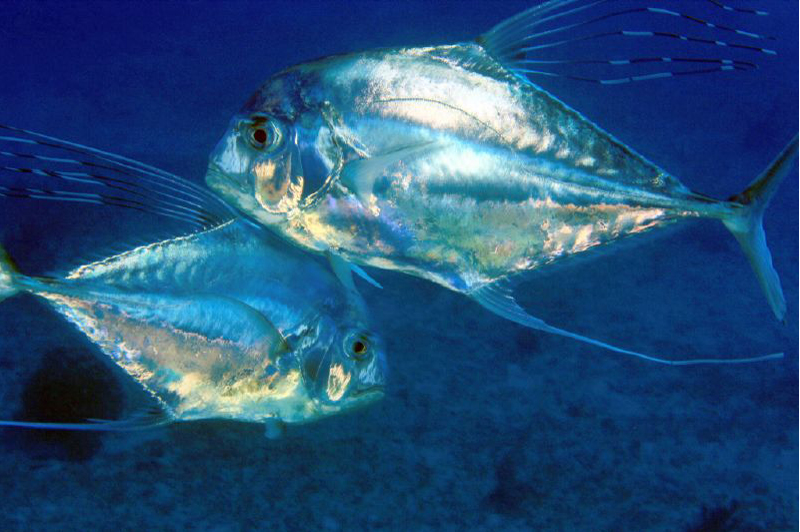Pennantfish, Alectis ciliaris (Bloch 1787)

Pennantfish, Alectis ciliaris, in the Bahamas. Source: Kevin Bryant / Flickr. License: CC by Attribution-NonCommercial-ShareAlike
A deep, very compressed metallic silvery-blue to silvery-grey trevally becoming silvery-white below, with a black blotch on the front part of the dorsal fin. Juveniles are almost diamond-shaped with 5 chevron-shaped dark bars on the side, a black blotch at base of 3rd to 6th soft dorsal-fin ray, and the filaments are black distally
The pelagic juveniles have extremely long filaments trailing from the dorsal and anal fins, and appear to mimic box jellyfishes with long trailing tentacles.
Pennantfish, Alectis ciliaris (Bloch 1787)
More Info
|
Distribution |
Widespread in Australia, from Dunsborough, Western Australia, around the tropical north to Mallacoota, Victoria; also the Lord Howe Province and Norfolk Island in the Tasman Sea. Elsewhere, the species occurs worldwide in tropical and subtropical coastal waters, and is widespread in the Indo-West Pacific. Adults inhabit coastal waters, while juveniles are pelagic. |
|
Features |
Dorsal fin VII(embedded) + I,18-20; Anal fin II(embedded) + I,15-17; Gill rakers (lower arch) 12-17; Lateral-line scutes 8-30 (at rear of straight part of Llat). Body deep, compressed, becoming more elongate with growth; head profile broadly rounded in adults; suborbital depth relatively narrow, 0.8–1.0 in upper jaw length. Body superficially naked body, scales where present minute and embedded. profile of nape and head broadly round, scutes present along rear of lateral line. Pectoral fins falcate, greater than head length; anal fin rays sometimes filamentous in adults; juveniles with elongate pelvic fins that lack filaments, and extremely long, filamentous anterior dorsal and anal-fin rays. |
|
Colour |
Mostly silvery with a light metallic bluish tinge on upper 1/3 of body and head; |
|
Feeding |
Feeds mainly on fishes and crustaceans. |
|
Similar Species |
Juvenile Diamond Trevally, Scyris indica, have elongate filaments on the pelvic fins that are lacking in juvenile Pennanfish. Adult Pennantfish also have a more rounded head profile, versus the more angular head profile of the Diamond Trevally. |
|
Etymology |
The specific name is from the Latin cilium (= eyelash) in reference to the elongate dorsal and anal-fin rays of juveniles. |
|
Species Citation |
Zeus ciliaris Bloch 1787, Naturg. ausländ. Fische: 36, pl. 191. Type locality: Surat, India (as East Indies). |
|
Author |
Bray, D.J. 2022 |
|
Resources |
Pennantfish, Alectis ciliaris (Bloch 1787)
References
Allen, G.R. 1997. Marine Fishes of Tropical Australia and South-east Asia. Perth : Western Australian Museum 292 pp. 106 pls.
Allen, G.R. & Erdmann, M.V. 2012. Reef fishes of the East Indies. Perth : Tropical Reef Research 3 vols, 1260 pp.
Allen, G.R., Hoese, D.F., Paxton, J.R., Randall, J.E., Russell, B.C., Starck, W.A., Talbot, F.H. & Whitley, G.P. 1976. Annotated checklist of the fishes of Lord Howe Island. Records of the Australian Museum 30(15): 365-454 figs 1-2
Bloch, M.E. 1787. Naturgeschichte der ausländischen Fische. Berlin : J. Morino Vol. 3 146 pp. pls 181-216.
Francis, M. 1993. Checklist of the coastal fishes of Lord Howe, Norfolk, and Kermadec Islands, southwest Pacific Ocean. Pacific Science 47(2): 136-170 figs 1-2
Francis, M.P. 2019. Checklist of the coastal fishes of Lord Howe, Norfolk and Kermadec Islands, southwest Pacific Ocean, Version: 2019.1, https://doi.org/10.6084/m9.figshare.c.4428305
Gloerfelt-Tarp, T. & P.J. Kailola. 1984. Trawled fishes of southern Indonesia and northwestern Australia. Australian Development Assistance Bureau, Australia, Directorate General of Fishes, Indonesia, and German Agency for Technical Cooperation, Federal Republic of Germany. 407 pp.
Grant, E.M. 1975. Guide to Fishes. Brisbane : Queensland Government, Co-ordinator General’s Department 640 pp.
Grant, E.M. 2002. Guide to Fishes. Redcliffe : EM Grant Pty Ltd 880 pp.
Gunn, J.S. 1990. A revision of selected genera of the family Carangidae (Pisces) from Australian waters. Records of the Australian Museum, Supplement 12: 1-77
Hutchins, J.B. & Swainston, R. 1986. Sea Fishes of Southern Australia. Complete field guide for anglers and divers. Perth : Swainston Publishing 180 pp.
Johnson, J.W. 2010. Fishes of the Moreton Bay Marine Park and adjacent continental shelf waters, Queensland, Australia. pp. 299-353 in Davie, P.J.F. & Phillips, J.A. Proceedings of the Thirteenth International Marine Biological Workshop, The Marine Fauna and Flora of Moreton Bay. Memoirs of the Queensland Museum 54(3)
Kimura, S., Takeuchi, S. & Yadome, T. 2022. Generic revision of the species formerly belonging to the genus Carangoides and its related genera (Carangiformes: Carangidae). Ichthyological Research. https://doi.org/10.1007/s10228-021-00850-1
Kuiter, R.H. 1993. Coastal Fishes of South-eastern Australia. Bathurst : Crawford House Press 437 pp.
Okiyama, M. 1993. An atlas of the early stage fishes in Japan. Koeltz Scientific Books, Germany. 1154 p. (In Japanese)
Randall, J.E. 2005. Reef and shore fishes of the South Pacific. New Caledonia to Tahiti and the Pitcairn Islands. University of Hawaii Press, Honolulu, Hawaii. 720 pp.
Randall, J.E., Allen, G.R. & Steene, R. 1990. Fishes of the Great Barrier Reef and Coral Sea. Bathurst : Crawford House Press 507 pp. figs.
Randall, J.E., Allen, G.R. & Steene, R. 1997. Fishes of the Great Barrier Reef and Coral Sea. Bathurst : Crawford House Press 557 pp. figs.
Russell, B.C. 1983. Annotated checklist of the coral reef fishes in the Capricorn-Bunker group, Great Barrier Reef, Australia. Great Barrier Reef Marine Park Authority. Special Publication Series 1: 1-184 figs 1-2
Russell, B.C. & Houston, W. 1989. Offshore fishes of the Arafura Sea. The Beagle 6(1): 69-84.
Sainsbury, K.J., Kailola, P.J. & Leyland, G.G. 1985. Continental Shelf Fishes of Northern and North-Western Australia. Canberra : Fisheries Information Service 375 pp. figs & pls.
Smith-Vaniz, W.F. 1999. Family Carangidae. pp. 2659-2756 in Carpenter, K.E. & Niem, T.H. (eds). The Living Marine Resources of the Western Central Pacific. FAO Species Identification Guide for Fisheries Purposes. Rome : FAO Vol. 4 2069-2790 pp.
Watson, W., Charter, S.R., Moser, H.G., Ambrose, D.A. & Sandknop, E.M. 1996. Carangidae: jacks. pp. 914-953 in Moser, H.G. (ed.) The early stages of fishes in the California Current Region. California Cooperative Oceanic Fisheries Investigations (CalCOFI) Atlas No. 33. Allen Press, Inc., Lawrence, Kansas. 1505 pp.





